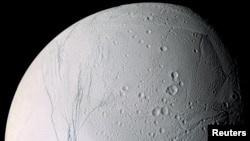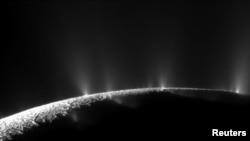An international team of scientists says it has found high levels of phosphorus in ice from Saturn’s moon Enceladus.
Phosphorus is a necessary element for many biological processes on Earth.
The researchers said the ice crystals shot out from an ocean beneath the moon’s surface.
The discovery came from data collected by NASA’s Cassini spacecraft. Cassini collected the data during its 13-year exploration of the huge planet, its rings, and its moons from 2004 to 2017. Cassini was the first spacecraft to orbit Saturn.
The German-led team published their findings in Nature, a science magazine. NASA’s Jet Propulsion Laboratory (JPL) in the western U.S. state of California also announced the findings. JPL designed and built the Cassini spacecraft.
Earlier, the same team confirmed that Enceladus’ ice grains are rich in minerals and complex organic compounds. The team said the ice includes the necessary elements to create amino acids, which are important molecular structures for life.
Phosphorus is the least common of the six chemical elements considered necessary to all living things. The others are carbon, oxygen, hydrogen, nitrogen, and sulfur. Now, scientists have found them all on Enceladus.
"It's the first time this essential element has been discovered in an ocean beyond Earth," said the study's lead writer, Frank Postberg. He is a planetary scientist at the Free University in Berlin in Germany.
Phosphorus is necessary for DNA, the genetic instructions in cells. It is also an important part of energy formation and transportation in life on Earth.
The researchers studied measurements taken by Cassini as it passed through salt-rich ice grains released into space by geysers found on the southern part of the moon. The geysers were erupting from the ice-covered ocean beneath the surface of Enceladus.
The substances are the same material that creates one of Saturn’s rings, called the “E” ring. The E ring can be found outside the planet’s brighter main rings.
Cassini discovered the ice-covered ocean. Since then, Enceladus has been a favorable target in the search for places in our solar system that could support life. Enceladus is about one-seventh the size of Earth’s moon and the sixth largest among Saturn’s 146 known natural satellites.
Jupiter’s moon Europa is also believed to have an ocean beneath its icy surface.
Computer modeling by the study’s co-writers in Europe and Japan shows that phosphorus exists in concentrations at least 100 times higher than in Earth’s oceans.
Christopher Glein is a planetary scientist at Southwest Research Institute in San Antonio, Texas. He took part in the research. He said the discovery was important. Glein said there could be enough phosphorus to support life in Enceladus’ ocean.
The scientists noted that finding phosphorus, complex organic compounds, water, and other things is evidence that Enceladus could possibly support life. Life, either past or present, has not been confirmed anywhere beyond Earth.
"Whether life could have originated in Enceladus' ocean remains an open question," Glein added.
I’m Gregory Stachel.
Steve Gorman reported this story for Reuters. Gregory Stachel adapted it for VOA Learning English.
__________________________________________________________________
Words in This Story
spacecraft – n. a vehicle that is used for travel in outer space
crystal –n. a form of a mineral in which the molecules are ordered in a regular way
rings – n. something that is shaped like a circle
grain –n. any very small, rounded object
organic – adj. of, relating to, substances that contain the element carbon and which are necessary for life
essential –adj. extremely important and necessary
geyser – n. a hole in the ground that shoots out hot water and steam
erupt – v. to send out rocks, ash, or lava in a sudden explosion
concentration – n. the amount of an ingredient in a mixture
originate – v. to begin to exist
_______________________________________________________________
What do you think of this story?
We want to hear from you. We have a new comment system. Here is how it works:
- Write your comment in the box.
- Under the box, you can see four images for social media accounts. They are for Disqus, Facebook, Twitter and Google.
- Click on one image and a box appears. Enter the login for your social media account. Or you may create one on the Disqus system. It is the blue circle with “D” on it. It is free.
Each time you return to comment on the Learning English site, you can use your account and see your comments and replies to them. Our comment policy is here.










Forum